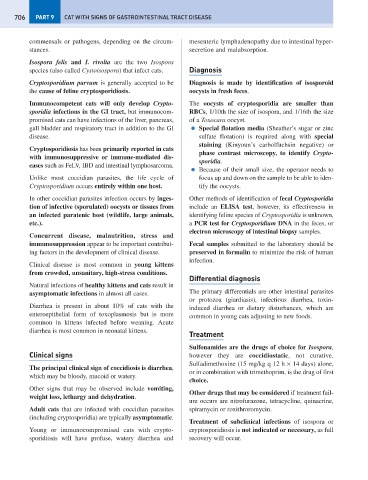Page 714 - Problem-Based Feline Medicine
P. 714
706 PART 9 CAT WITH SIGNS OF GASTROINTESTINAL TRACT DISEASE
commensals or pathogens, depending on the circum- mesenteric lymphadenopathy due to intestinal hyper-
stances. secretion and malabsorption.
Isospora felis and I. rivolta are the two Isospora
species (also called Cystoisospora) that infect cats. Diagnosis
Cryptosporidium parvum is generally accepted to be Diagnosis is made by identification of isosporoid
the cause of feline cryptosporidiosis. oocysts in fresh feces.
Immunocompetent cats will only develop Crypto- The oocysts of cryptosporidia are smaller than
sporidia infections in the GI tract, but immunocom- RBCs, 1/10th the size of isospora, and 1/16th the size
promised cats can have infections of the liver, pancreas, of a Toxocara oocyst.
gall bladder and respiratory tract in addition to the GI ● Special flotation media (Sheather’s sugar or zinc
disease. sulfate flotation) is required along with special
staining (Kinyoun’s carbolfuchsin negative) or
Cryptosporidiosis has been primarily reported in cats
phase contrast microscopy, to identify Crypto-
with immunosuppressive or immune-mediated dis-
sporidia.
eases such as FeLV, IBD and intestinal lymphosarcoma.
● Because of their small size, the operator needs to
Unlike most coccidian parasites, the life cycle of focus up and down on the sample to be able to iden-
Cryptosporidium occurs entirely within one host. tify the oocysts.
In other coccidian parasites infection occurs by inges- Other methods of identification of fecal Cryptosporidia
tion of infective (sporulated) oocysts or tissues from include an ELISA test, however, its effectiveness in
an infected paratenic host (wildlife, large animals, identifying feline species of Cryptosporidia is unknown,
etc.). a PCR test for Cryptosporidium DNA in the feces, or
electron microscopy of intestinal biopsy samples.
Concurrent disease, malnutrition, stress and
immunosuppression appear to be important contribut- Fecal samples submitted to the laboratory should be
ing factors in the development of clinical disease. preserved in formalin to minimize the risk of human
infection.
Clinical disease is most common in young kittens
from crowded, unsanitary, high-stress conditions.
Differential diagnosis
Natural infections of healthy kittens and cats result in
asymptomatic infections in almost all cases. The primary differentials are other intestinal parasites
or protozoa (giardiasis), infectious diarrhea, toxin-
Diarrhea is present in about 10% of cats with the induced diarrhea or dietary disturbances, which are
enteroepithelial form of toxoplasmosis but is more common in young cats adjusting to new foods.
common in kittens infected before weaning. Acute
diarrhea is most common in neonatal kittens.
Treatment
Sulfonamides are the drugs of choice for Isospora,
Clinical signs however they are coccidiostatic, not curative.
Sulfadimethoxine (15 mg/kg q 12 h × 14 days) alone,
The principal clinical sign of coccidiosis is diarrhea,
or in combination with trimethoprim, is the drug of first
which may be bloody, mucoid or watery.
choice.
Other signs that may be observed include vomiting,
Other drugs that may be considered if treatment fail-
weight loss, lethargy and dehydration.
ure occurs are nitrofurazone, tetracycline, quinacrine,
Adult cats that are infected with coccidian parasites spiramycin or roxithroromycin.
(including cryptosporidia) are typically asymptomatic.
Treatment of subclinical infections of isospora or
Young or immunocompromised cats with crypto- cryptosporidiosis is not indicated or necessary, as full
sporidiosis will have profuse, watery diarrhea and recovery will occur.

